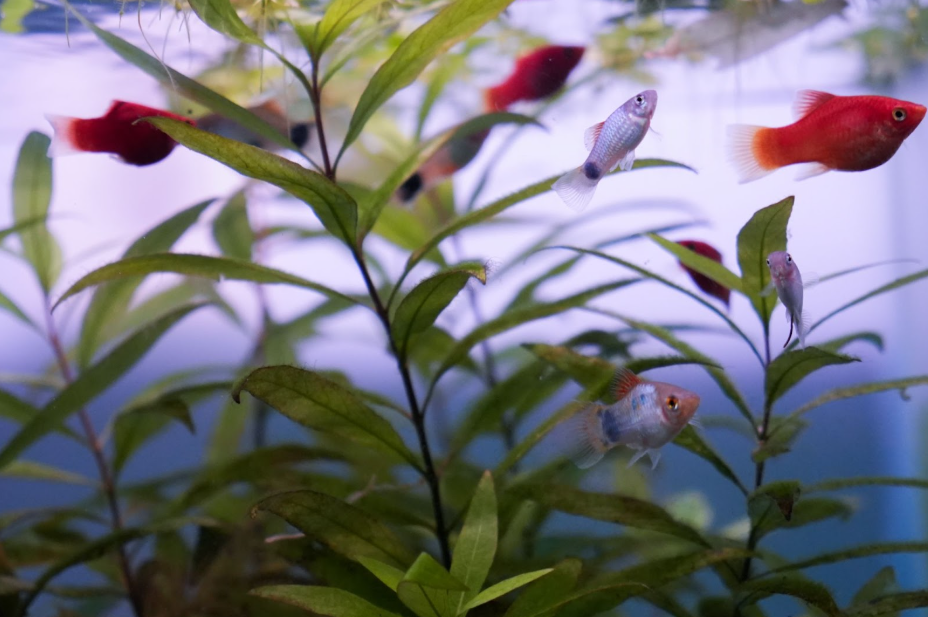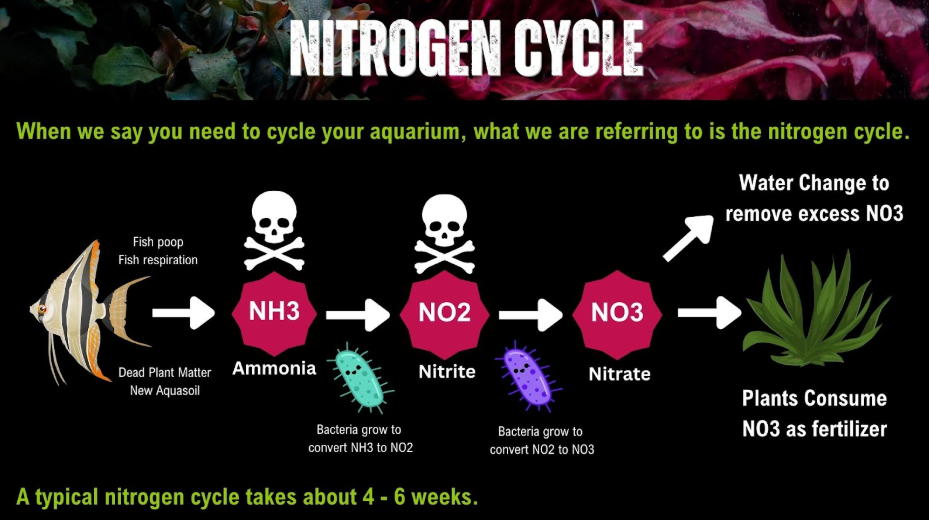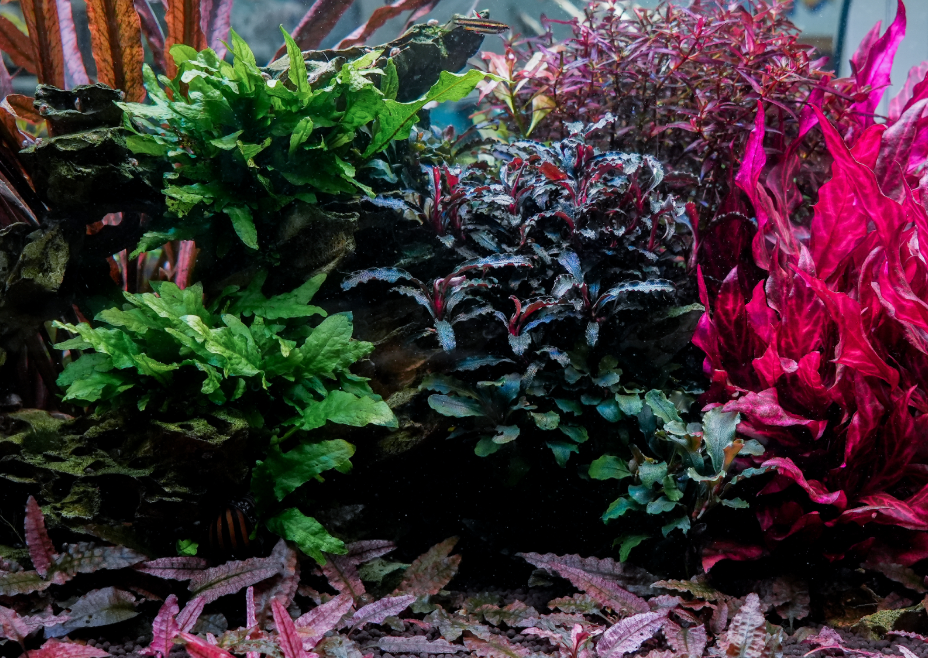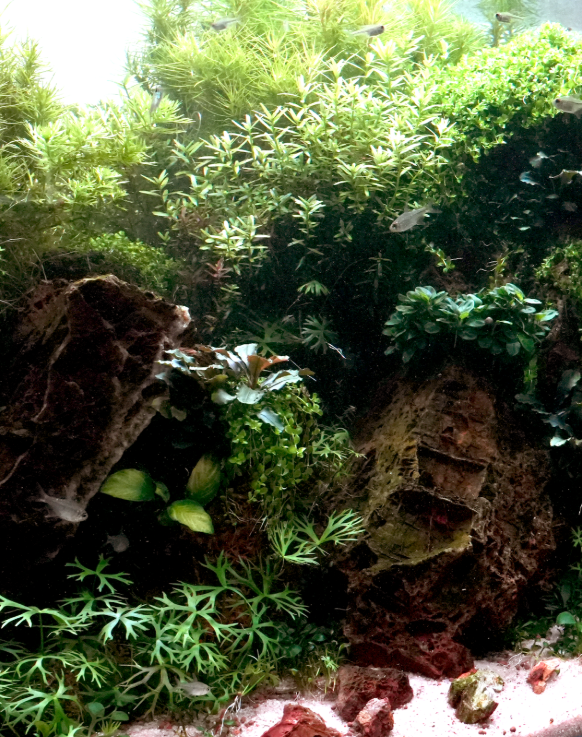How to Set Up a Freshwater Planted Aquarium: A Beginner’s Guide
Apr 10th 2025

Apr 10th 2025

Along with being an exquisite aesthetic feature of your home, a fully planted freshwater aquarium offers a fully enveloping and rewarding hobby that brings a part of nature indoors. Looking at the planted tanks and watching the colorful tropical fish swim around is breathtaking. However, achieving the supposed perfect freshwater aquarium is not as easy as it seems; it takes strategy, implementation, and continuous upkeep.
At first glance, setting up a freshwater-planted aquarium may seem complicated. However, with the right directions, it is possible to create a balanced ecosystem. This article will provide detailed instructions on how to pick an aquarium and proper equipment, maintain plant life, select livestock, and maintain your aquarium.
Here’s everything that you need to know to get started on this new adventure!
A planted aquarium can be advantageous for seasoned and beginner aquarists in many ways. Plants in a freshwater aquarium create a beautiful and natural ecosystem, enhancing the environment for aquatic inhabitants and onlookers alike. An aquarium can be calming and therapeutic, which research indicates can lead to reduced stress levels. It can also help slow down the heart and reduce blood pressure, making it a beneficial addition to homes, offices, and even hospitals.
Apart from reducing stress, a freshwater aquarium offers a great opportunity to nurture an interest in nature, inspire creativity, and introduce responsibility to young children. A planted aquarium allows fish enthusiasts to grasp concepts of biological filtration, the nitrogen cycle, and how plants help provide stable water conditions for aquatic life.
Aquascaping goes beyond keeping fish in a glass box. It allows you to express yourself creatively and artistically. It involves carefully recreating a natural landscape diorama using stone, wood, soil, and live plants.
Setting up an aquarium seems daunting because of the work involved in creating a cohesive aquascape, keeping up with maintenance, and knowing how to address challenges like algae. There are an endless number of options, from a novice preferring an uncomplicated, low-maintenance tank with easy plants to an expert aquarist building an elaborate, high-tech planted aquarium.
Having an aquarium teaches responsibility and patience and allows children to appreciate aquatic life. As time goes by, enthusiasts learn to differentiate between the many species of aquatic life, learn appropriate plant and animal husbandry, the importance of filtration, and the art and science of aquascaping. When aquarists experience success with their first aquarium, they are likely to continue their hobby for life.
Setting up and maintaining a freshwater-planted aquarium is much simpler than maintaining a saltwater tank. Freshwater fish are generally more robust, need less specialized knowledge and equipment, and can be more forgiving of novice mistakes. Aquatic plants uptake nitrogenous waste and make it easier to maintain good water quality.

The first thing to do when getting ready to set up a freshwater aquarium is to choose the proper size, shape, and placement. The fish’s overall health and the tank’s ecosystem all depend on the decisions you make now. Thoughtful planning leads to easier maintenance, less stress for the fish, and a reduction in several common problems associated with aquariums, such as subpar water quality or algae blooms.
The location of your aquarium is just as important as the size. Some of the most important aspects to consider are the following:
Aquarium enthusiasts must first identify the necessary equipment to build and maintain a successful aquatic environment. Starting correctly prevents algae, unbalanced water conditions, loss of plant or aquatic life, and much more while easing routine maintenance tasks. Your tank's ability to stay clean and keep livestock healthy is dependent on your adherence to a maintenance schedule and employing the use of proper equipment.
Many beginners do not value equipment quality, which leads to the naive idea that a fish, some water, gravel, and a tank are all that is necessary. Contrary to this belief, a functional freshwater-planted aquarium requires filtration, a nutrient-rich planting substrate, and sufficient lighting to be truly effective. Without these key items, maintaining a healthy planted aquarium is impossible.
Here is a list of essential equipment to help novices ease the process of creating a freshwater-planted aquarium.
The filter provides biological and mechanical filtration, which helps break down and remove fish waste from the water column. Water movement from the filter also ensures proper aeration.
Choose between:
Most tropical fish prefer water temperatures of anywhere between 75°F and 82°F. Thermometers and heaters maintain and monitor the environment’s stability.
Lighting plays a crucial role in photosynthesis and plant coloration. WRGB LED lights (White, Red, Green, Blue) enhance the natural hues of aquatic plants and promote healthy growth.
Recommended WRGB LED lights:
A high-quality aqua soil is essential for planted aquariums, providing vital nutrients and maintaining stable water parameters. Unlike inert substrates, aqua soil releases nutrients directly to plant roots and helps buffer pH for optimal plant growth. Some top choices include ADA Amazonia, Tropica Aquarium Soil, and Oase Scaperline Soil.
When starting a beginner aquascape, selecting the right hardscape is crucial for creating a visually appealing and functional aquarium environment. Hardscape refers to the wood, stone, and other aquarium-safe decor items that form the foundation of your underwater landscape. These elements not only enhance the aesthetic but also serve as planting mediums for epiphytes like Java fern, Anubias, Bucephalandra, and various mosses. Choosing the right hardscape material for your aquascape is essential for plant health and overall design.
When selecting your hardscape materials, avoid mixing different types of wood and rock. Stick to one type of wood and one type of rock to maintain a cohesive look and balance in your aquascape. Matching your hardscape to your soil type can enhance plant growth and aesthetic harmony.
What’s more, be sure to leave enough space for maintenance between your hardscape and the aquarium walls, allowing for easy access during cleaning. While it may be tempting to find the perfect piece, creating your ideal hardscape often involves combining several elements. To prevent wood from floating, anchor it to heavy stones and secure it together using aquarium-safe super glue and cotton. This ensures stability and allows you to build a stunning, functional aquascape that will thrive in your aquarium.
Some popular hardscape materials include seiryu stone, dragon stone, spider wood, and driftwood.
Water chemistry is crucial for the fish’s well-being, especially since the slightest irregularities in water parameters can result in stress, disease, or mortality.
Knowing about the nitrogen cycle, pre-conditioning water before adding fish, and regularly changing water are all mandatory tasks to maintain safe and stable conditions in the aquarium.

An aquarium should go through a nitrogen cycle before adding fish to allow the formation of helpful bacteria that digest waste. Adding a culture of beneficial bacteria like Microbe-Lift Special Blend will help speed up and boost the nitrogen cycle.
Pro Note: This step takes around 4-6 weeks.

Selecting appropriate fish species ensures that any beginner can succeed and create an easy-to-upkeep aquarium. Not every fish is fit for new tanks, and all fish will have certain requirements such as aquarium size, diet, compatibility, and water parameters.
Choosing fish that are suitable for beginners and that are highly adaptable, peaceful, and not aggressive makes the overall experience much more enjoyable. Avoiding challenges in the form of aggression, disease, or algae growth caused by excess fish waste is incredibly helpful.
When choosing fish, consider their specific behavioral characteristics, adult size, and relationships with other species. Betta fish, for example, are best kept individually, while tetras are social and like to swim in schools. Stress and territorial behavior are consequences of overstocking a freshwater tank and the selection of incompatible species. Understanding the requirements of certain species, such as water temperature, diet, and aquarium size, helps establish the right environment.
The ideal candidates for beginners are fish that can tolerate minor changes in water conditions. Such species have greatly reduced the chances of contracting stress-related diseases, making them ideal for newcomers.
Here are a few beginner-friendly fishes for amateur aquarists:
A well-maintained, planted aquarium can be an amazing habitat for various fish and plants. Plants help prevent issues with water quality, algae buildup, and the health of the fish. Although the plants do a lot of cleaning, ignoring regular maintenance will put your panted tank at risk of developing issues with nutrient imbalances in your plants.
Taking care of a freshwater planted tank shouldn’t take a lot of time or advanced skills. If you avoid overfeeding, perform regularly scheduled water changes, and ensure your filter media is clean and unclogged, keeping the tank in good condition is easy. Adopting proper practices and being disciplined in upkeep can maintain an aquatic ecosystem with little effort.

When selecting plants for your aquascape, consider their care requirements to ensure they thrive in the environment you’re creating. Each plant has different needs, from lighting to CO2 levels, and understanding these requirements is key to successful aquascaping. Red plants, for instance, typically require CO2 injection to maintain their vibrant colors, with few exceptions. Carpeting plants, which form lush, dense mats, also need bright lighting and added CO2 for optimal growth.
At Fitz Fish Ponds, we provide detailed descriptions of each plant on our website to help you choose the right plants for your setup. If you need further guidance, our staff can always assist you, ensuring you make the best plant selections for your aquascape!
When selecting plants, consider their placement within the aquarium. Consider some of these beginner plants for each region of the aquarium:
Preparing your plants properly before planting is important to ensure they settle into their new home smoothly.
When planting in soil, it’s important to give rosette plants ample space to grow and reach their mature size.
Regular maintenance is essential to keep your aquascape thriving and looking its best. Always remove dead or dying leaves from your plants to prevent decay from affecting the rest of the aquarium.
Stem plants, such as Rotala or Ludwigia, can be propagated easily through trimming. When you trim these plants, cut just below a leaf node to encourage new growth. The cut portion can be replanted to form a new plant, helping to maintain a lush aquascape.
Keep carpeting plants short to prevent them from lifting off the soil and creating an uneven carpet.
Rhizome plants like Anubias and Java Fern can be split by cutting the rhizome into smaller pieces, each with roots, to create multiple plants.
If left unchecked, mosses can become too bushy and detach from the hardscape, so regular trimming is important to keep them manageable. When trimming moss, siphon the debris as you go, as moss does not float like other plants.
Your plants will remain healthy and beautiful for years with proper care and regular maintenance.
Sustaining a planted freshwater aquarium is undoubtedly pleasurable and will give you a sense of accomplishment. Nevertheless, it poses numerous challenges for nearly everyone, especially those new to it. Keeping your fish alive is one thing, but understanding basic concepts like tank size, water parameters, and other critical factors is daunting.
You can find answers to all your problems in this FAQ section, which is filled with valuable tips such as adding fish and controlling algae growth. It does not matter if you are a novice or wish to remodel your setup; you will find this information helpful!
First, select an appropriate tank size for the livestock you wish to keep and/or the space you have available. Apart from the tank, you will need a filter, heater, substrate, hardscape, light, and other decorations. Make sure the aquarium completes its nitrogen cycle before introducing fish so that beneficial bacteria can populate it and sustain life.
Allow 4-6 weeks for the aquarium to complete the nitrogen cycle before adding fish. If the nitrogen cycle is complete and a sufficient amount of beneficial bacteria has colonized the aquarium, ammonia and nitrites should not be present.
20 gallons is an ideal aquarium size for beginners. Having more space reduces the intensity of water chemistry fluctuations. Bigger tanks dilute fish waste considerably and allow for the sustainability of consistent temperatures.
Your aquarium should be positioned on a solid, level stand. On average, an aquarium weighs about 10 lbs per gallon. It should be placed away from direct sun to prevent algae growth and extreme temperature fluctuations. It should also be placed next to a power source for all of the equipment.
You will require a filter, heater, thermometer, lighting, substrate, and water conditioner. For maintenance, you should have 5-gallon buckets, towels, planting tweezers, plant scissors, algae scrubbers, a siphon tube, and a net.
How do I prepare tap water for my fish tank?
Using a water conditioner can achieve water free from chlorine and chloramines. It is also recommended to check water parameters to ensure it is safe to put fish in. This can be done using a water test kit or by bringing water to an FFP retail location or your local fish store for testing.
Bettas, tetras, platies, and Corydoras catfish are the best options for beginners. They are all easy to care for, and they adapt quickly.
Tropical fish are best kept at 72 to 82 degrees Fahrenheit, with 78 degrees being the standard for most pre-set heaters. Always adjust your heat for the livestock you are keeping. Plants prefer temperatures in the lower end of that range (78 or under), and lower temperatures produce less algae. A heater and thermometer on hand guarantee the temperature is accurate and constant.
Give fish food one or two times daily and ensure the food is gone in three minutes. It is even okay to skip a day of feeding each week to keep waste levels at a minimum and improve the metabolic health of your fish. Not following this routine will result in poor-quality water due to excess waste.
To keep the water quality high, perform a weekly water change of 10 - 20% of the water. Clean debris from your pre-filter sponges (in the bucket of old aquarium water), replace any water polishing pads, and scrub algae from glass surfaces during your water change. Fertilize your plants, dose the aquarium with an algae inhibitor like Flourish Excel or 2Hr Aquarist APT Fix, and remove any floating waste daily. Add a dose of Microbe-Lift Special Blend once every two weeks to maintain your beneficial bacteria and keep populations healthy.
The nitrogen cycle is important because it establishes beneficial bacteria that transform noxious ammonia (resulting from fish excretion) into much less dangerous nitrites and even less harmful nitrates.
Can I replace live plants with artificial plants?
Live plants in your aquarium improve biological filtration, increase oxygenation, and consume nitrates, keeping the water quality healthy. Fish behave more naturally in an aquarium full of live plants and tend to have brighter colors, increase breeding behavior, and hide less. While plastic plants don’t require any care, they provide little benefit to the aquarium other than aesthetics and places for fish to hide.
Algae growth can be controlled by preventing direct sunlight from hitting the tank, putting the tank light on a timer and only for 6-8 hours a day, not overfeeding your fish, installing lots of live plants, and performing routine water changes. Scrub algae off of hard surfaces and employ an algae-eating crew of amano shrimp, otocinclus catfish, and nerite snails.
Nitrates are produced from the processing of harmful ammonia and nitrites by beneficial bacteria. This conversion happens in the filter media, substrate, and all surfaces of a freshwater aquarium. Live plants consume nitrates as food and remove them from the water column.
Float your bag of fish in your aquarium for 15-20 minutes with the lights turned off to reduce stress. After that, begin adding small amounts of water from the tank into the bag. Repeat for around 30 minutes, working toward a goal of having a bag that is a 50/50 combination of tank and bag water. Net the fish out of the bag and add them to the aquarium. Keep the lights out until the next day so the fish can acclimate better.
Dramatic changes to water chemistry through inappropriate or neglected maintenance practices, overfeeding the fish, putting too many fish in an aquarium all at once or before the nitrogen cycle is complete, and forgetting to dechlorinate aquarium water are common novice mistakes.
Indeed, ensuring that a tank’s size is appropriate for the desired quantity of fish and that the fish species are compatible with each other is crucial.
Healthy fish have a good appetite and are active. They have bright skin, no eye problems, and show no abnormal signs like white dots or ragged fins. Gasping on the surface of water and clamped fins can indicate poor health and possibly poor water quality.
You’ll need lighting that mimics natural sunlight for a healthy planted tank. LED lights are the most common choice, as they are energy-efficient and can be adjusted to suit different plant needs. Plants typically require 6-8 hours of light per day. Choose lighting with a spectrum that supports plant growth, usually 6,500K to 10,000K.
While CO2 injection is not strictly necessary for all plants, it’s essential for high-demand plants, especially red plants and carpeting plants like Rotala macrandra or Dwarf Baby Tears. CO2 helps plants photosynthesize more efficiently, leading to faster growth and intense coloration. If you have low-light or low-maintenance plants, such as Java Fern or Anubias, you can usually grow them without CO2.
Beginner-friendly plants include species that are hardy and adaptable to various water conditions. Some popular choices are:
These plants are forgiving and don’t require high light or CO2 to thrive.
Plants need nutrients like nitrogen, phosphorus, potassium, and trace elements to grow well. Liquid fertilizers or root tabs can provide essential nutrients. You may need to dose more frequently if you have a high-light tank or CO2 injection. Following the manufacturer’s recommendations and avoiding over-fertilizing is important, as this can lead to algae growth.
There are several reasons why plants may not thrive:
Assess your lighting, fertilization, and water quality to correct these issues. Regular water changes and proper tank conditions will also help keep plants healthy.
Start by planning where each plant will go based on its growth requirements. Foreground plants, like Monte Carlo, should be planted in the front, while taller plants like Vallisneria or Rotala should go in the background. When planting, be sure to space plants properly to allow for growth and avoid overcrowding. Use tweezers to plant small or delicate plants and ensure their roots are properly anchored in the substrate.
Trimming is necessary to keep your plants healthy and maintain the shape of your aquascape. Stem plants should be trimmed regularly to prevent becoming too tall and leggy. Carpeting plants must be trimmed to prevent them from lifting off the substrate. Rhizome plants like Java Fern can be divided by cutting the rhizome into smaller sections. Remove any dead or decaying leaves to keep your aquarium clean.
While you can grow plants in regular aquarium gravel, nutrient-rich substrates are ideal for plant growth. Substrates like aqua soil, fluorite, or eco-complete provide essential nutrients to the plants' roots, encouraging healthier and more vibrant growth. If using a regular gravel or sand substrate, consider adding root tabs to provide nutrients for your plants.
Algae thrive in aquariums when excess nutrients and light are available. When imbalances occur in a planted tank, algae can compete with plants for nutrients and light. To prevent algae growth, ensure your plants are healthy, adjust fertilization, keep up with aquarium maintenance, and maintain proper lighting intensity and duration. Floating plants and fast-growing stem plants can help absorb excess nutrients, and regular water changes will keep the tank clean.
Yes, you can mix various types of plants in the same tank. However, it is more important to choose plants with care requirements suitable to your aquarium setup. For example, high-light plants that require CO2 injection will not do well in an aquarium with low light or even no CO2. Arrange your plants appropriately according to their growth patterns so nothing gets shaded or overcrowded.
These FAQs address the most common concerns for freshwater-planted aquariums. By following these tips, you can create a thriving, healthy aquatic environment. Always research specific plant care needs and ask for help when needed!
For assistance with designing, setting up, or maintaining a freshwater aquarium, Fitz Fish Ponds offers professional aquascaping services that will surely help you. Let us help you today with transforming your home or office space with a stunningly beautiful aquatic masterpiece!
Fitz Fish Ponds has expert staff available who provide professional help with aquascaping and designing stunning freshwater ecosystems to ensure that your aquarium meets your expectations. Our staff is eager to assist with any requirements, ranging from selecting fish to creating planted tanks, transforming existing tanks, and even garden caregiving services.
Give us a ring today at (908) 420-9908 so we can assist you in accomplishing the aquarium of your dreams. You can also talk To An Expert (during regular business hours)!
| Hours | |
|---|---|
| sunday | Closed |
| monday | Closed |
| tuesday | 10:00-5:00 |
| wednesday | 10:00-5:00 |
| thursday | 10:00-5:00 |
| friday | 10:00-5:00 |
| saturday | 10:00-5:00 |
| Hours | |
|---|---|
| sunday | 10:00-5:00 |
| monday | Closed |
| tuesday | 11:00-6:00 |
| wednesday | 11:00-6:00 |
| thursday | 11:00-6:00 |
| friday | 11:00-6:00 |
| saturday | 10:00-5:00 |
| Hours | |
|---|---|
| sunday | 10:00-4:00 |
| monday | Closed |
| tuesday | 10:00-5:00 |
| wednesday | 10:00-5:00 |
| thursday | 10:00-5:00 |
| friday | 10:00-5:00 |
| saturday | 10:00-5:00 |
| Hours | |
|---|---|
| sunday | 10:00-5:00 |
| monday | Closed |
| tuesday | 11:00-6:00 |
| wednesday | 11:00-6:00 |
| thursday | 11:00-6:00 |
| friday | 11:00-6:00 |
| saturday | 10:00-5:00 |
| Hours | |
|---|---|
| sunday | Closed |
| monday | 9:00-5:00 |
| tuesday | 9:00-5:00 |
| wednesday | 9:00-5:00 |
| thursday | 9:00-5:00 |
| friday | 9:00-5:00 |
| saturday | Closed |
| Hours | |
|---|---|
| sunday | 10:00-4:00 |
| monday | Closed |
| tuesday | 10:00-5:00 |
| wednesday | 10:00-5:00 |
| thursday | 10:00-5:00 |
| friday | 10:00-5:00 |
| saturday | 10:00-5:00 |
| Hours | |
|---|---|
| sunday | Closed |
| monday | Closed |
| tuesday | 10:00-5:00 |
| wednesday | 10:00-5:00 |
| thursday | 10:00-5:00 |
| friday | 10:00-5:00 |
| saturday | 10:00-5:00 |
| Hours | |
|---|---|
| Sunday | Closed |
| Monday | Closed |
| Tuesday | 10:00-5:00 |
| Wednesday | 10:00-5:00 |
| Thursday | 10:00-5:00 |
| Friday | 10:00-5:00 |
| Saturday | 10:00-5:00 |
| Hours | |
|---|---|
| Sunday | 10:00-4:00 |
| Monday | Closed |
| Tuesday | 10:00-5:00 |
| Wednesday | 10:00-5:00 |
| Thursday | 10:00-5:00 |
| Friday | 10:00-5:00 |
| Saturday | 10:00-5:00 |









| Hours | |
|---|---|
| sunday | Closed |
| monday | Closed |
| tuesday | 10:00-5:00 |
| wednesday | 10:00-5:00 |
| thursday | 10:00-5:00 |
| friday | 10:00-5:00 |
| saturday | 10:00-5:00 |
| Hours | |
|---|---|
| sunday | 10:00-5:00 |
| monday | Closed |
| tuesday | 11:00-6:00 |
| wednesday | 11:00-6:00 |
| thursday | 11:00-6:00 |
| friday | 11:00-6:00 |
| saturday | 10:00-5:00 |
| Hours | |
|---|---|
| sunday | 10:00-4:00 |
| monday | Closed |
| tuesday | 10:00-5:00 |
| wednesday | 10:00-5:00 |
| thursday | 10:00-5:00 |
| friday | 10:00-5:00 |
| saturday | 10:00-5:00 |
| Hours | |
|---|---|
| sunday | 10:00-5:00 |
| monday | Closed |
| tuesday | 11:00-6:00 |
| wednesday | 11:00-6:00 |
| thursday | 11:00-6:00 |
| friday | 11:00-6:00 |
| saturday | 10:00-5:00 |
| Hours | |
|---|---|
| sunday | Closed |
| monday | 9:00-5:00 |
| tuesday | 9:00-5:00 |
| wednesday | 9:00-5:00 |
| thursday | 9:00-5:00 |
| friday | 9:00-5:00 |
| saturday | Closed |
| Hours | |
|---|---|
| sunday | 10:00-4:00 |
| monday | Closed |
| tuesday | 10:00-5:00 |
| wednesday | 10:00-5:00 |
| thursday | 10:00-5:00 |
| friday | 10:00-5:00 |
| saturday | 10:00-5:00 |
| Hours | |
|---|---|
| sunday | Closed |
| monday | Closed |
| tuesday | 10:00-5:00 |
| wednesday | 10:00-5:00 |
| thursday | 10:00-5:00 |
| friday | 10:00-5:00 |
| saturday | 10:00-5:00 |
| Hours | |
|---|---|
| Sunday | Closed |
| Monday | Closed |
| Tuesday | 10:00-5:00 |
| Wednesday | 10:00-5:00 |
| Thursday | 10:00-5:00 |
| Friday | 10:00-5:00 |
| Saturday | 10:00-5:00 |
| Hours | |
|---|---|
| Sunday | 10:00-4:00 |
| Monday | Closed |
| Tuesday | 10:00-5:00 |
| Wednesday | 10:00-5:00 |
| Thursday | 10:00-5:00 |
| Friday | 10:00-5:00 |
| Saturday | 10:00-5:00 |
